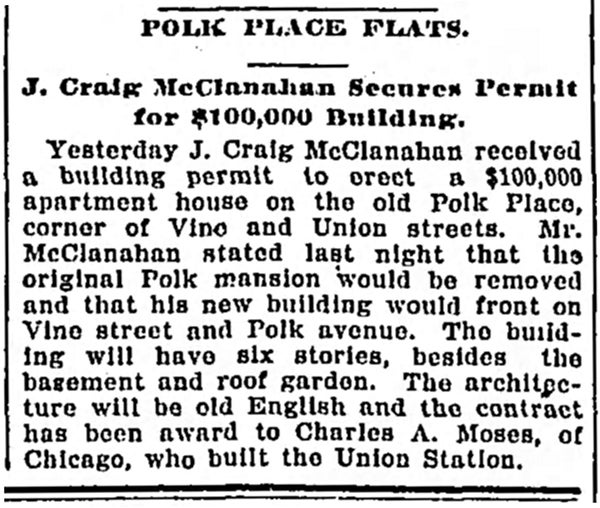The worst architectural crime in Tennessee history
Published 4:44 pm Tuesday, August 2, 2022
|
Getting your Trinity Audio player ready...
|
On December 5, 1900, an advertisement appeared on page 5 of the Nashville American advertising “building stone” for sale near the corner of Eighth Avenue and Church Street.
This tiny ad pinpoints the date of the worst architectural crime in Tennessee history. You see, the stones were all that was left of the home of President James K. Polk.
Our 11th president accomplished much during his four-year term from 1845 until 1849. Through the Mexican-American War and direct purchase from Great Britain, he acquired more than a million square miles of land for the United States, including the states of Texas, California, Oregon, Washington, Nevada and others. He lowered the tariff on goods that were imported into the United States. He oversaw the process under which the first U.S. postage stamp was issued. The naval academy was created during his presidency.
At only 53, Polk was the youngest former president in American history. He looked forward to retiring at Polk Place, a home in the heart of Nashville that he and his wife had acquired from his late mentor, Felix Grundy. But it was not to be.
On June 15, 1849 — only 103 days after leaving office — Polk died of cholera. At first his body was buried at Nashville’s City Cemetery, but it was later moved to a grave in the front yard of Polk Place.
Sarah Childress Polk wore black (to show she was in mourning) every day for the rest of her life. But she remained one of Nashville’s most highly respected citizens for the next 42 years.
Polk Place was revered by people from every political persuasion. During the Civil War, the home and grounds were considered neutral ground. In spite of the fact that she had nephews fighting on the Confederate side, Union Generals Buell and Grant frequently paid their respects to the former first lady.
Mrs. Polk didn’t venture out much, other than attending weekly church services at the First Presbyterian Church three blocks away (where a pew still bears her name). Instead, people of all types called on her. In the 1870s and 1880s, all members of the Tennessee General Assembly would come to Polk Place after the legislature dismissed.
Mrs. Polk died in 1891. What followed was a legal dispute centered on James K. Polk’s will, and eventually that will was declared invalid. The state of Tennessee nearly acquired Polk Place and made it the governor’s mansion (at the time, the governor of Tennessee stayed in a hotel room). But that did not occur; instead, on September 19, 1893, the state had the graves of President and Mrs. Polk dug up and moved to the grounds of the Tennessee State Capitol.
Another several years of argument ensued, during which the Polk Place mansion fell into even more disrepair. Then, on February 5, 1898, the Davidson County Chancery Court auctioned the Polk Place home and grounds for $15,000.
Eventually, the land ended up in the hands of a developer named J. Craig McClanahan, who tore down the Polk Place mansion and built a six-story apartment building on the site.
All of this may make you wonder about the Polk home and museum in Maury County. Built in 1816 by the president’s father, Samuel Polk, James K. Polk lived in the Columbia house for about six years, when he was a young lawyer. The Columbia house remained in the Polk family until 1871. Thanks to donations by several people, including President Polk’s grand niece, the Columbia home was acquired by the state in 1929 and set aside as a museum.
I highly recommend a visit to the James K. Polk Home in Columbia. A few weeks ago I held an inservice there which was attended by about 35 teachers and the tour guides there were wonderful. In fact, there are several pieces of furniture and artwork in the Columbia house that Mrs. Polk kept at Polk Place — so I’m happy to report that the former president’s possessions are worth more to us now than they were in December 1900.
Bill Carey is the founder of Tennessee History for Kids, a non-profit organization that helps teachers cover social studies.





